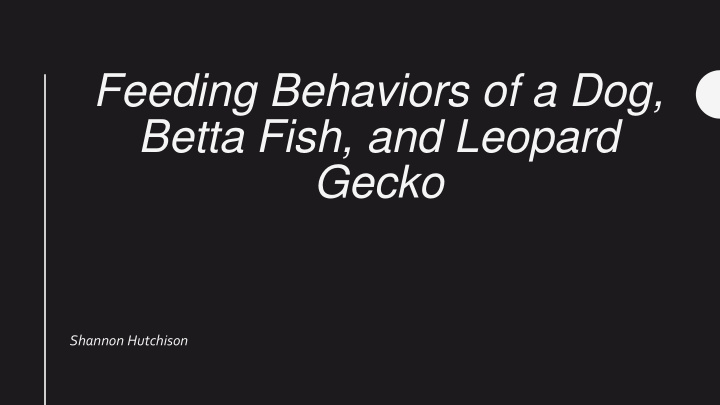



Feeding Behaviors of a Dog, Betta Fish, and Leopard Gecko Shannon Hutchison
• Several breeds are known for rapid consumption of food • May be from wolf ancestors • Had to compete for food • May also be adaptation from scavenging in early domestication • Taste buds primarily respond to amino acids • Can also respond to some “fruity sweet” compounds found in plants • Odor may play a role in food selection • Dogs without ability to smell show less discrimination between different types of food • Most of the dog’s teeth is used for biting, grasping, and tearing • Dogs have four molars • Dog mouths can only move up and down
• Rigel • Female Shetland sheepdog mix, 5 years old • Food • Iams Proactive Health Minichunks dry dog food – ¾ cup • Abound Lamb and Brown Rice we dog food – 2 tbsp • 900mg fish oil • Feeding Time • 5:26
Behavior Description Percent Time Approaching The act of moving towards the food bowl with the intention to eat 7.36% Eating Prehension, chewing, and swallowing of the food 60.74% Licking food Using tongue to touch food without casting any into mouth 9.51% Licking lips Wiping tongue across lips 21.17% Sitting Upright with hind legs folded beneath body and forelegs extended. 3.37% Not eating food Surveying The act of looking at surroundings while standing at food dish 10.12% Watching door The act of leaving the food to look at the front door 11.35%
Video 1
70 60 50 40 Time (%) 30 20 10 0 Sitting Surveying Approaching Licking food Eating Licking lips Looking at door Behavior
• Primarily carnivores • Eat insects in the wild • Upturned mouth allows betta to suck air and eat prey at surface • Tiny, sharp teeth for breaking down food before swallowing
• Male Betta Fish • Food • Aqueon Betta Food • Feeding Time • 2:45
Behavior Description Percent Time Approaching The act of moving towards the food bowl with the intention to eat 4.24% Drifting Floating, only movement is caused by water 7.88% Eating Prehension, chewing, and swallowing of the food 8.48% Heating Floating next to heater to get warm 46.67% Lunging A surge in movement in order to catch the food 1.82% Searching The act of looking for more food 29.09% Waiting Floating near the bottom of the tank after not initially finding food 6.67%
Video 2
50 45 40 35 30 Time (%) 25 20 15 10 5 0 Heating Searching Waiting Approaching Lunging Eating Drifting Behavior
• Hunters • Prefer eating live insects • Crickets make up main portion of diet • Opportunistic feeders • Won’t search for prey, but will stalk when prey is in sight
• Godzilla • Adult female leopard gecko • Food • Crickets, dusted with calcium • Feeding Time • 2:59
Behavior Description Percent Time Eating Prehension, chewing, and swallowing of the food % Lunging A surge in movement in order to catch the food % Stalking The act of following or watching prey with the intent to catch it %
Video 3
70 60 50 40 Time (%) 30 20 10 0 Stalking Lunging Eating Behavior
70 60 50 40 Time (%) 30 20 10 0 Approaching/Stalking Lunging Eating Behavior Dog Betta Gecko
Recommend
More recommend